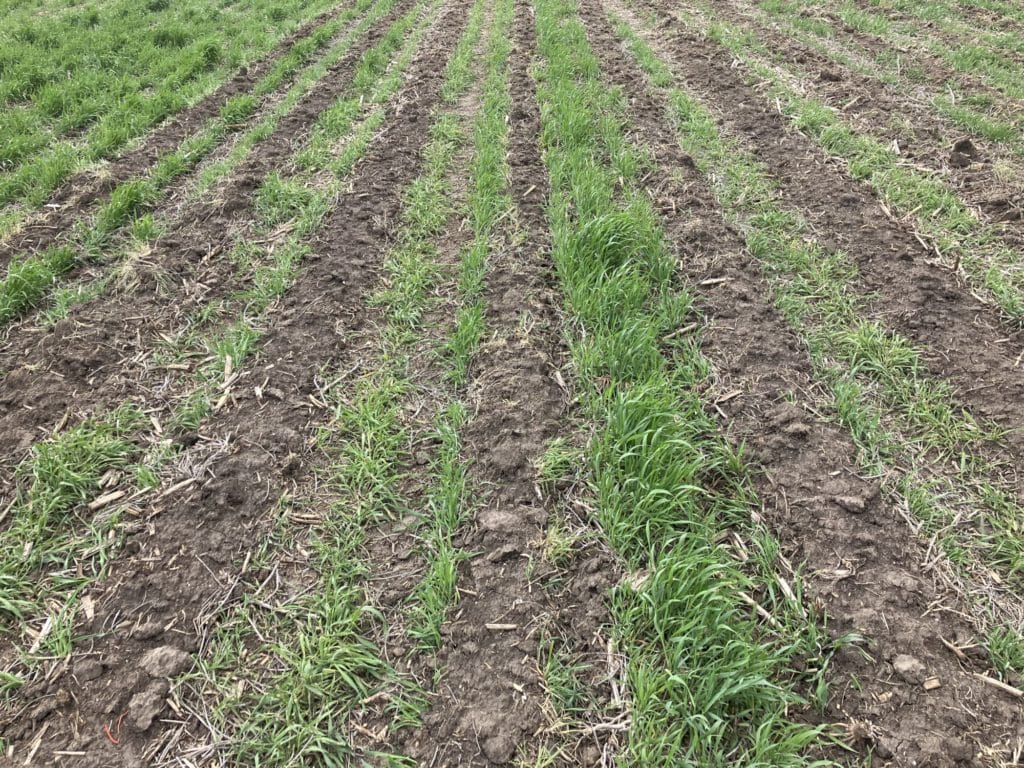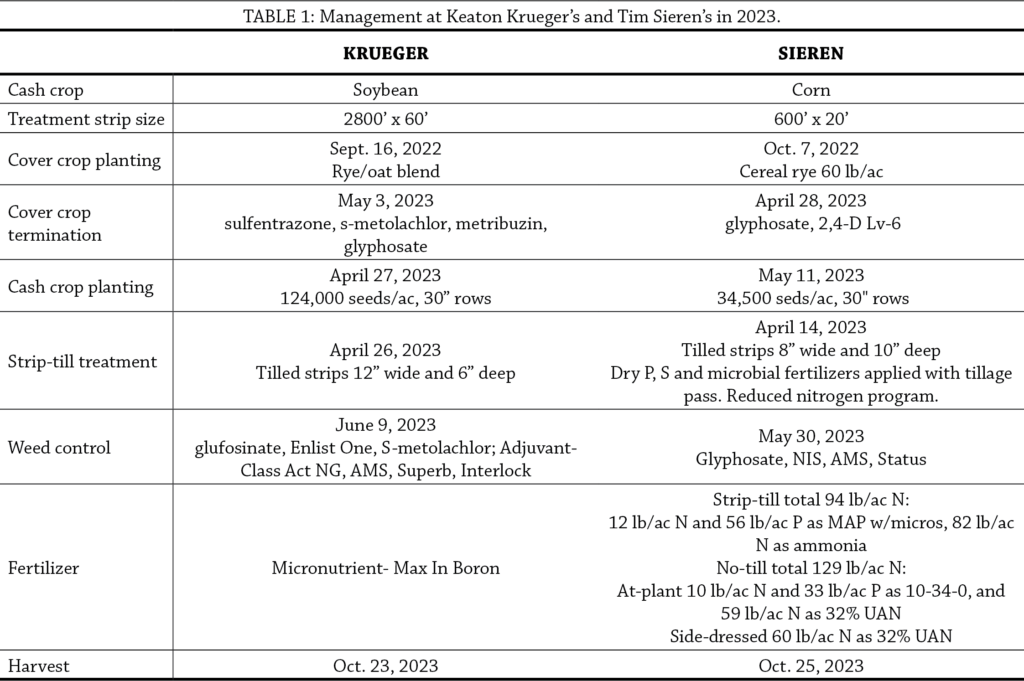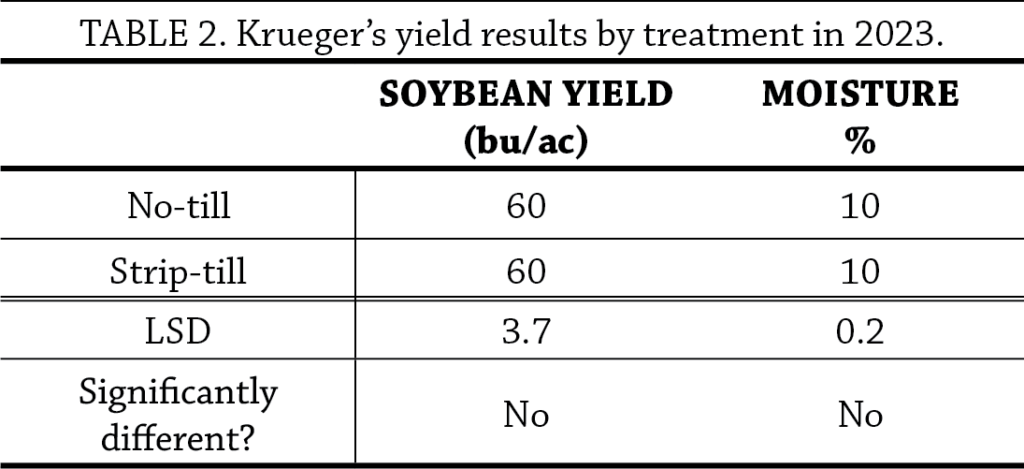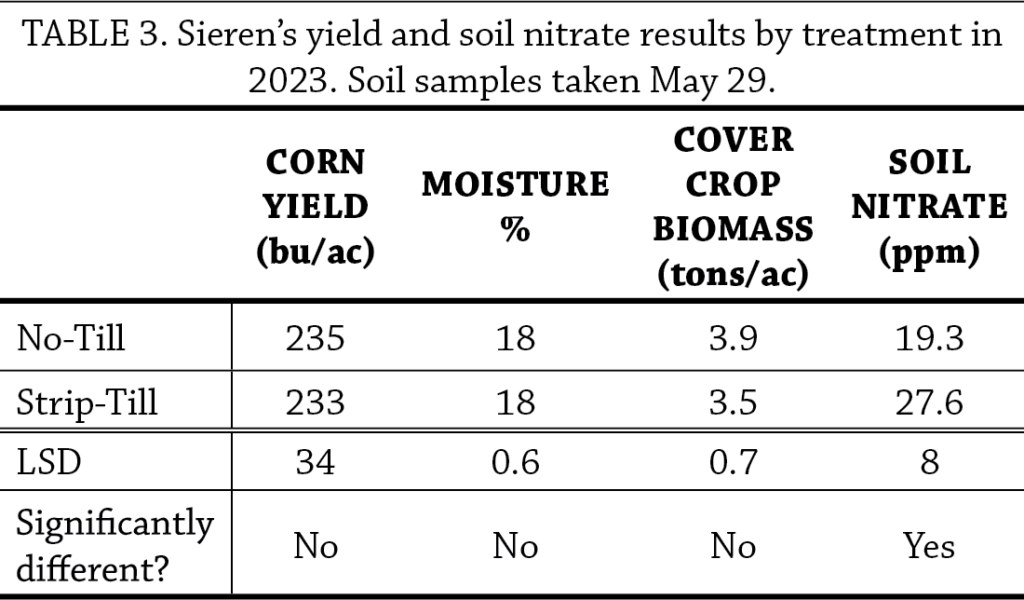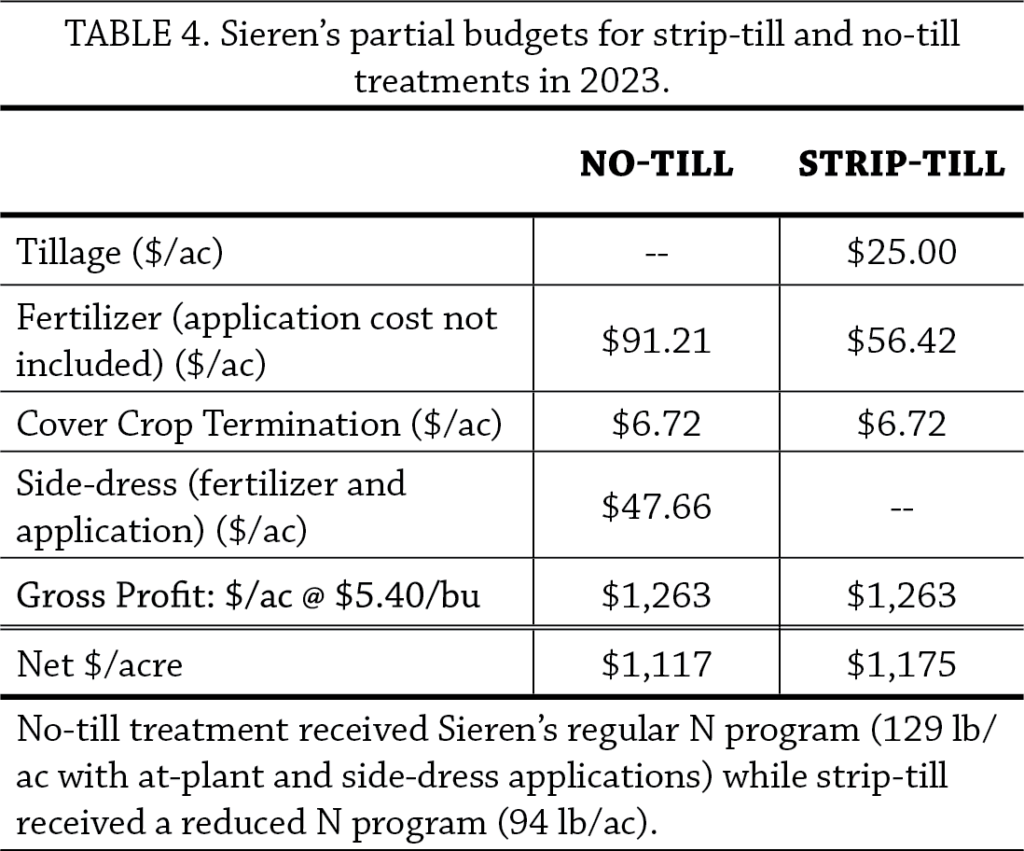This research report was funded by Cargill.
In a Nutshell:
- Many farmers plant corn and soybeans in cover cropped fields using either no-till drilling or strip tillage before planting. Strip tillage requires an extra equipment pass compared to no-till but may result in higher yields.
- Iowa farmers Keaton Krueger and Tim Sieren investigated how strip-till vs. no-till planting soybeans (Krueger) and corn (Sieren) affected crop yields.
Key Findings:
- Despite a lower soybean stand count in his no-till treatment, Krueger found no differences in yield between no-till and strip-till treatments.
- Sieren also found no significant yield differences between no-till and strip-till planted corn. His strip-till system, however, resulted in a higher ROI because he reduced fertilizer amounts in this treatment.
Background
Conservation tillage practices are gaining popularity because they reduce soil erosion and nutrient loss, compaction, greenhouse gas emissions, energy inputs, and time compared to traditional tillage practices [1]. Common conservation tillage practices include no-till planting and strip-till planting. No-till planting is the practice of directly drilling seeds into undisturbed soil, often after physically and/or chemically terminating a cover crop, while strip tillage is the practice of tilling soil in a narrow strip to plant crops into and leaving the interrow space undisturbed. In addition to the environmental and cost benefits of these conservation tillage practices, most research from the Midwest shows that no-till and strip-till systems result in similar yields to traditional tillage practices [2, 3, 4]. However, some researchers have documented lower yields in no-till systems especially in colder years [2,3].
Keaton Krueger and Tim Sieren both use strip tillage to prepare cover cropped fields for soybean and/or corn planting. However, they recognize that removing the strip-till pass in favor of no-till planting would further reduce their planting input costs and time commitments. They both think no tillage would be preferable on their operations if there is no large negative yield impact. Sieren stated that “If I can obtain similar yields [using no-till] as strip-till, I can return to 100% no-till on my corn acres, reducing time, fuel, and machinery costs. I hope to increase no-till acres.” These cooperators designed a trial to test how strip-till vs. no-till planting soybeans (Krueger) or corn (Sieren) affected their crop yields. Sieren participated in a similar PFI Cooperators trial in 2019 where he found that strip tillage resulted in greater corn yields (by 15 bu/ac) and returns (by $31/ac), in part because the strip-till system also received an extra 11 lb N/ac [2]. This time, he chose to keep input costs constant across systems by reducing N fertilizer application in the strip-till system to account for the greater fuel and labor expense compared with the no-till system.
Methods
Design
Krueger planted soybeans following corn and a rye/oat cover crop in 2023 in two treatments; 1) strip-till and 2) no-till drilled. Sieren planted corn following soybeans and a cereal rye cover crop in 2023 in two treatments; 1) strip-till with a reduced N application rate, and 2) no-till drilled with a full nitrogen program. Sieren designed these treatments with different fertilizer rates so that each treatment would have the same input/management costs. Planting details and field management at both farms are presented in Table 1. Cooperators established treatments in randomized, paired strips: 2 treatments × 4 replications = 8 strips total.
Measurements
Both Krueger and Sieren recorded grain yield and moisture using a yield monitor or weigh wagon. Reported soybean yields are corrected to 13% moisture and corn yields are corrected to 15.5% moisture. The cooperators also documented costs of equipment passes and applied products. Sieren documented cover crop heights and biomass for each replicate and took soil samples for soil nitrates on May 29, 2023. Soil cores were 12-in.deep and 8 cores were taken spanning across the row.
Data analysis
To evaluate the effect of treatment on soybean or corn, we calculated the least significant difference (LSD) using a two-way ANOVA at the 95% confidence level. If the difference between the two treatments was greater than the LSD, we would expect such a difference to occur 95 times out of 100 under the same conditions – we refer to this as a statistically significant effect. On the other hand, if the resulting difference between the two treatments was less than the LSD, we would consider the results to be statistically similar. We could make these statistical calculations because both Krueger’s and Sieren’s experimental designs involved replication of their treatments (Figure A1).
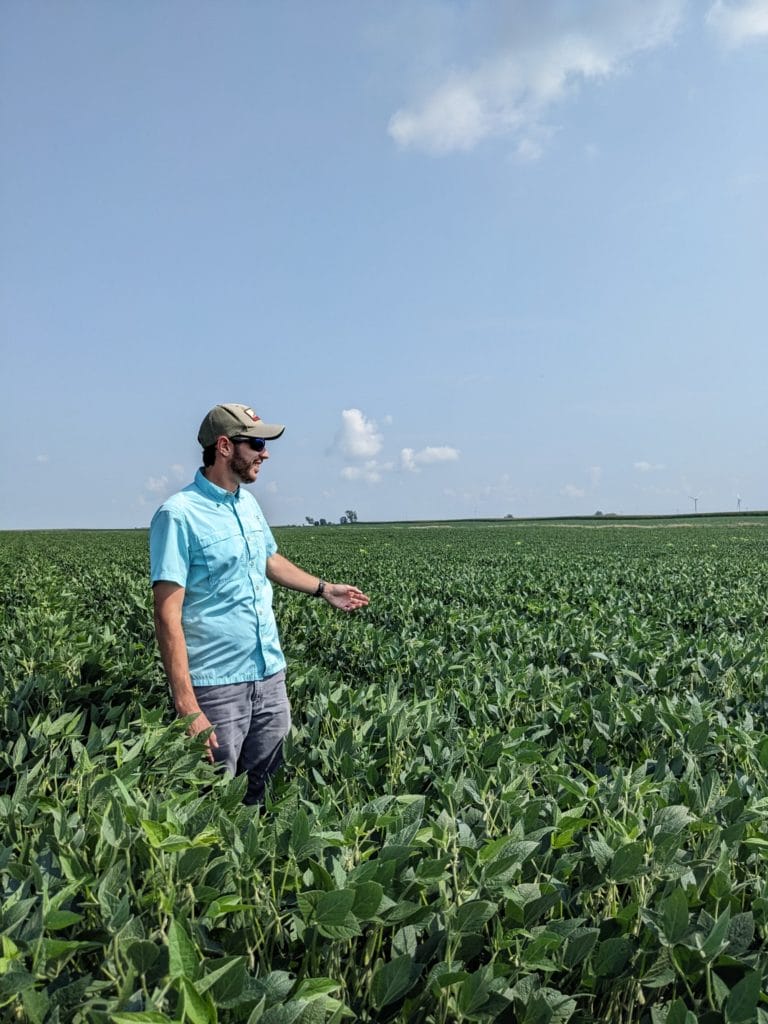
Keaton Krueger in his trial on August 8, 2023. There were no visible differences between treatments at this point in the summer.
Results and Discussion
Yield
Krueger observed poorer stand counts in his no-till strips (78,300 plants/acre) compared with his strip-till strips (98,000 plants/acre). However, he found no significant yield differences between the strip-till and no-till treatments (Table 2). He reports that “The really poor stand on the no-till acres did not affect yield like I expected it would. This really surprised me.”
Similarly, Sieren found no difference in corn yield between his no-till and strip-till treatments (Table 3). There was also no significant difference in cover crop biomass measured on April 19, which occurred after strip tillage (Apr. 14) but before cover crop termination (Apr. 28). However, soil nitrates were significantly higher in strip-till treatments compared to the no-till treatments, despite the fact that he applied 35 lb/ac less N in the strip-till treatments. This likely reflects higher soil nitrates in disturbed/tilled soil.
Return On Investment (ROI)
Krueger estimates that his strip tillage pass cost $20/ac. Because soybean yields and input costs were the same between his two treatments, this means that his strip-till treatment ROI was $20/ac less than his no-till treatment.
Sieren’s reduced fertilizer application in his strip-till treatment resulted in a greater ROI compared to his no-till treatment despite the increased cost of tillage in the strip-till treatment (Table 4). Sieren applied a total of 94 lb/ac N in his strip-till treatments and 129 lb/ac N in his no-till treatments (Table 2). Sieren has been reducing his N application rates in recent years so 129 lb/ac is his usual rate, and hog manure was last applied to the field in fall of 2021. There was no yield difference between the treatments despite the lower fertilizer rate. Since Sieren’s past research showed a significant decrease in corn yields under no-till vs. strip-till, it is possible that the extra nitrogen in the no-till treatment offset this yield deficit in 2023. However, more research might be needed to determine whether there is an optimal N fertilization rate to offset yield decline in no-till vs. strip-till corn while also not resulting in a lower ROI than strip tillage.
Conclusions and Next Steps
Both cooperators found no yield differences between strip-till and no-till treatments and found that their ROI was therefore higher when using no-till planting. Krueger says that “I’ll probably have to do the trial one more time next year on a different field to convince myself of the results.” Sieren, in contrast, is ready to adopt no-till corn planting. “I’ve been wanting to go back to 100% no-till and this trial has shown me how to do it without sacrificing yield.”
Appendix – Trial Design and Weather Conditions
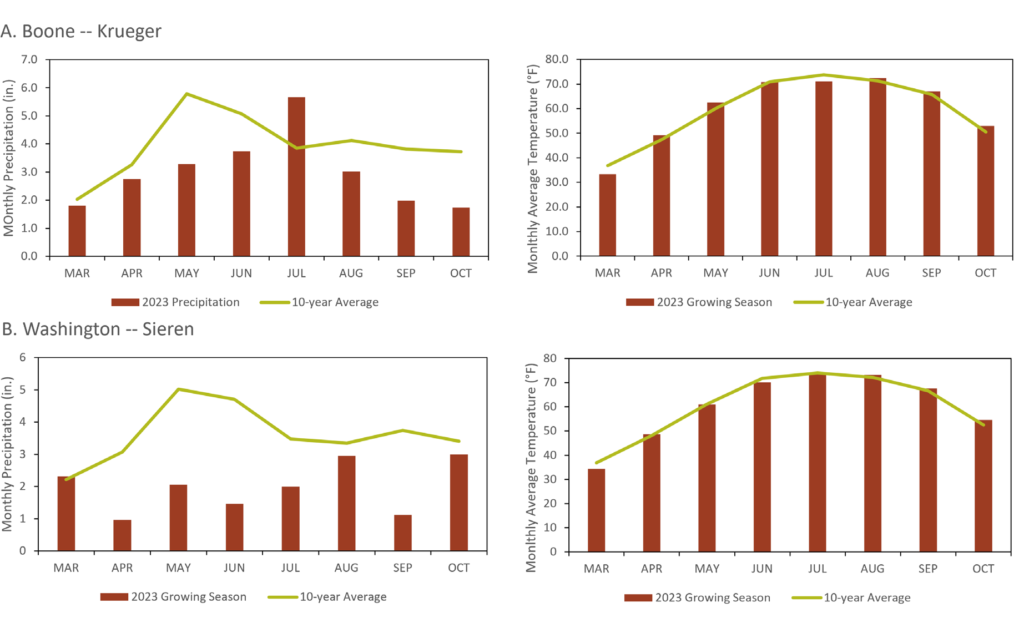
Figure A2. Monthly precipitation accumulation (left) and mean temperature (right) at Boone near Ogden, IA (Krueger) and and Washington near Keota, IA (Sieren). Click to enlarge.
References
[1] Bertold, J., and Sailus, M., eds. 2020. Conservation Tillage Systems in the Southeast: What is Conservation Tillage? https://www.sare.org/publications/conservation-tillage-systems-in-the-southeast/chapter-1-introduction-to-conservation-tillage-systems/what-is-conservation-tillage/. (Accessed June 13, 2023).
[2] Gailans, S., Boyer, J., Sieren, T., and Gustafson, J. 2019. No-till vs. Strip-till Corn and Soybeans Following a Cereal Rye Cover Crop. https://practicalfarmers.org/wp-content/uploads/2019/04/18.FC_.CC.No-vs.-strip-till-following-a-cover-crop.pdf. (Accessed June 13, 2023).
[3] DeJong-Hughes, J. and Vetsch, J. 2007. On-Farm Comparison of Conservation Tillage Systems for Corn Following Soybeans. https://conservancy.umn.edu/handle/11299/48314. (Accessed June 13, 2023).
[4] Nowatzki, J. and Endres, G., 2017. Strip-till for Field Crop Production. https://www.ag.ndsu.edu/publications/crops/strip-till-for-field-crop-production. (Accessed June 13, 2023).


